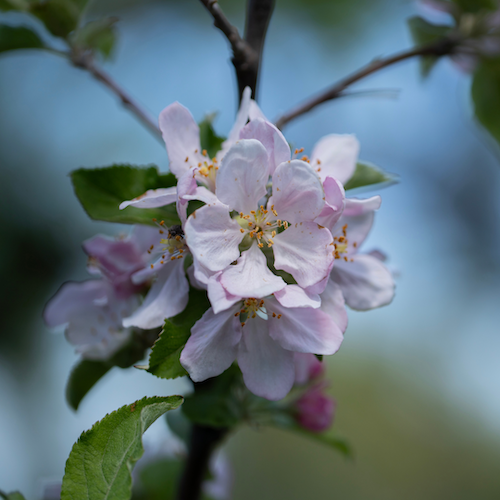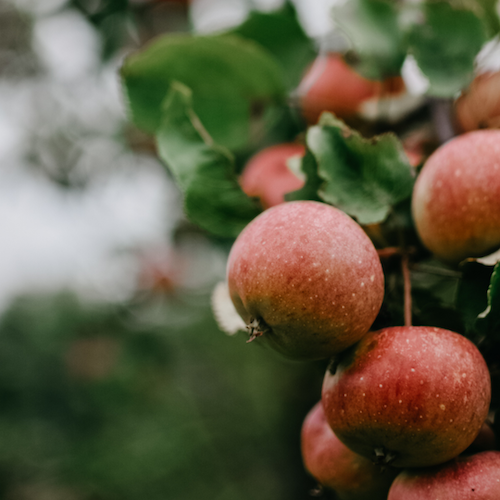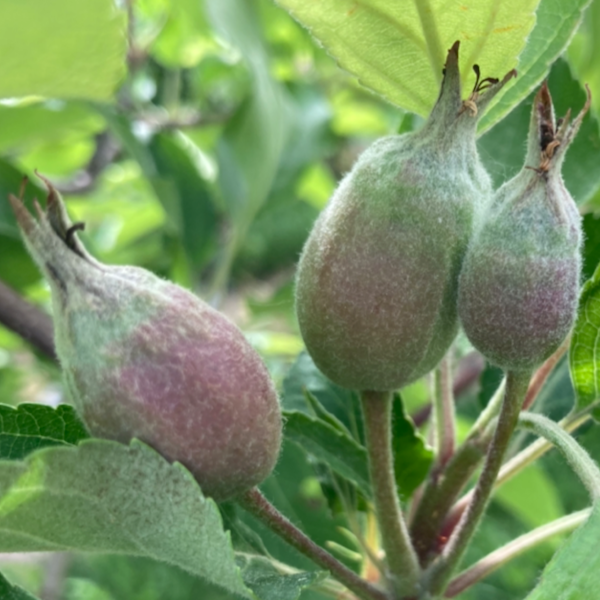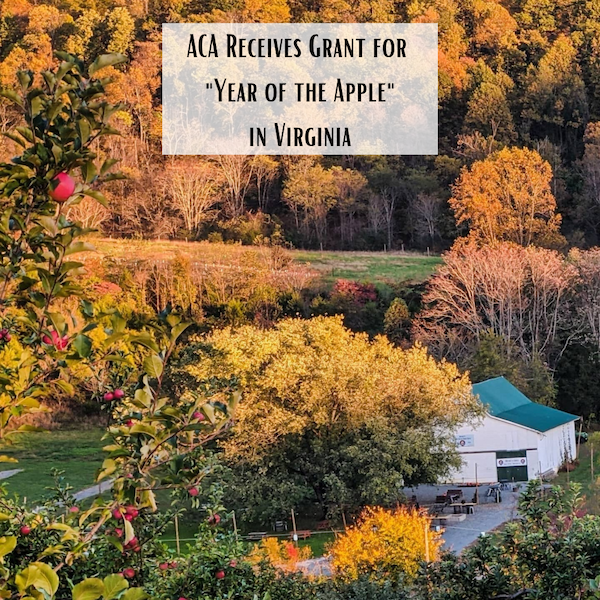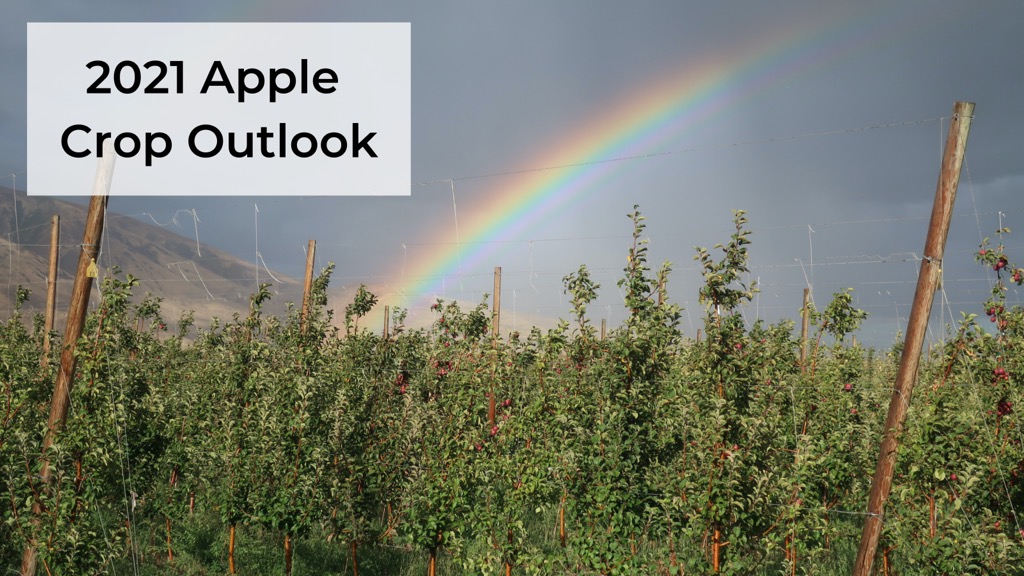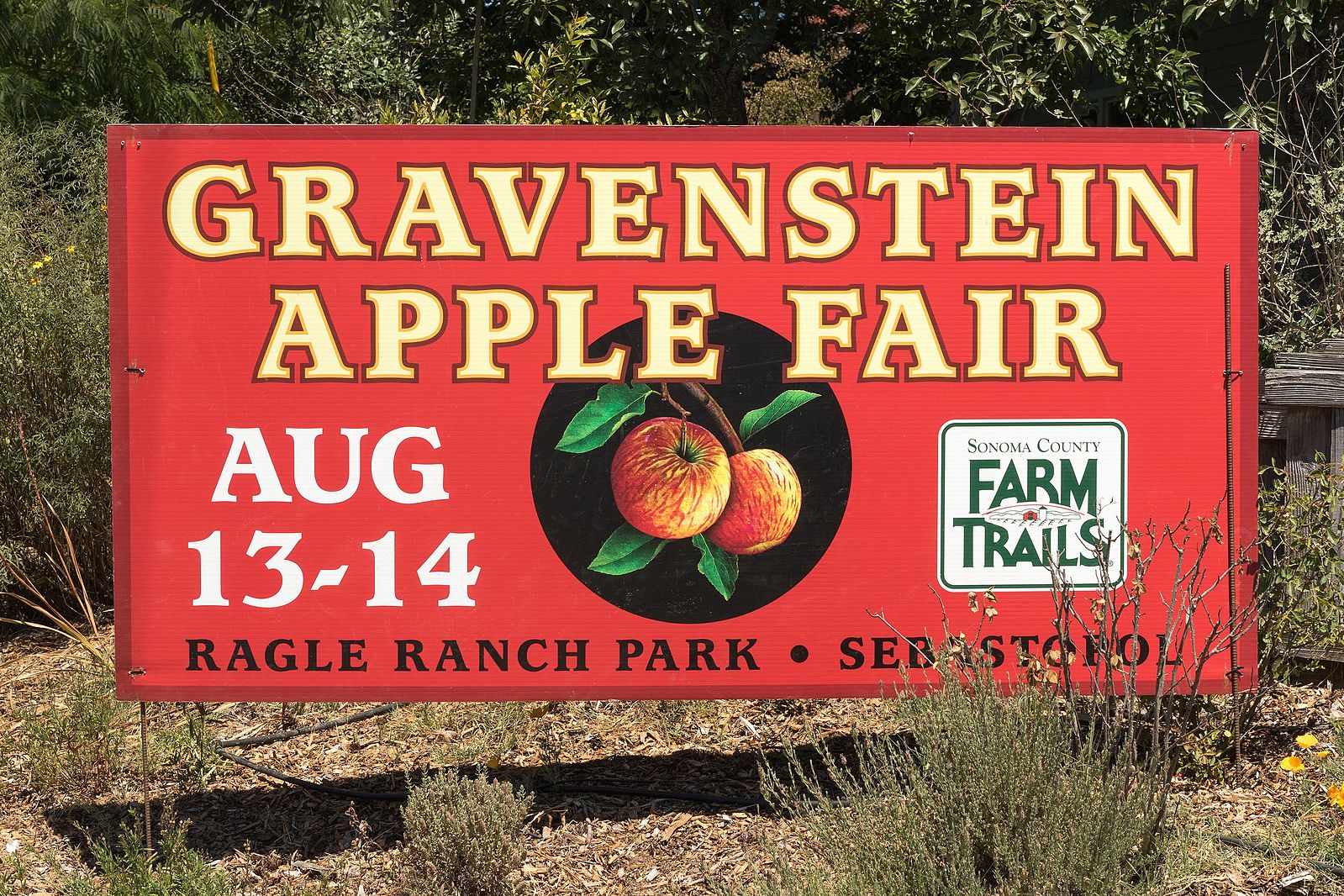Apples
2024 Apple Crop Outlook
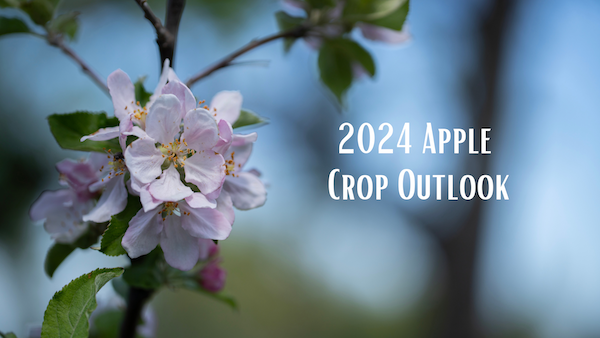
We reached out to experts in apple growing to get a look at the 2024 Apple Crop Outlook. Check out what these experts from around the U.S. had to say about this year’s apple crop.
David Glaize, Glaize Apples, Winchester, VA
August 15: The Virginia apple crop dodged some early frosts in the spring of 2024. We had terrific pollination weather and fruit set was strong. We suffered a severe drought in July/August which has kept the apples small, and is stressing the trees, especially the newly planted blocks. Some of the older trees are showing wilted leaves and have begun dropping fruit. However, rain and colder temps are starting to move in. The crop is looking good, and we will hopefully continue to get more size and color, although harvest did come slightly earlier than in years past. Virginia will harvest a good size crop this year, although acreage of processing fruit is still being pushed out due to a weak market.
Marcus Robert, Tieton Cider Works, Yakima, WA
August 5: Apple crop in Washington State looks promising with near-average volumes. Most areas avoided damage from spring frost and return bloom on most varieties was healthy. Biannual bearers, like Golden Delicious and Honey Crisp, look to have small yields this year. All in all, the state is predicting 120-125 million box crop. This is down from the previous season of 134 million boxes but much higher than 2022’s crop of 104 million boxes. Although sales volumes have been higher than previous years, at the current rate of sales WA State looks to have 8 weeks of inventory from 2023 in storage as of the date of this report, August 5, 2024. New crop will start harvest in the next few weeks.
Gregory Peck, Cornell University, New York
July 24: The cider apple crop in New York is shaping up to be one of the best in recent years. After a few years of freeze events and disease outbreaks, it’s nice to see so many apples (and pears!) throughout the State. New York had a couple of scary mornings on April 24 and 25 when many apple varieties had already reached bud break and the temperature dropped to the low 20’s, but thankfully there was minimal damage to most orchards. There has been adequate precipitation and plenty of heat this summer to help size up the fruit. A warm spring led to an early bloom, which means that growers and cider producers should anticipate apples to ripen a week or more early this year. Additionally, some farms had a spotty fruit set on a few varieties, and so cider producers will need to be creative about which apples to blend to create their established products. Although harvest is still more than a month away, there should be plenty of high-tannin and other specialty cider apples available for the State’s craft producers and for others looking to purchase New York grown cider apples.
Megan Muehlbauer, Rutgers University, New Jersey
July 15: The spring of 2024 was a normal one. Phenology moved along as expected. There were no significant freeze events in New Jersey, which is in part why there is a very heavy crop set at most farms. The greatest concern right now is the hot dry weather, which has lead to some leaf hopper issues and the potential for sunburn of the fruit. Growers have had to irrigate a bit this year since the rains have been sporadic and spotty.
The dry weather has helped to minimize the disease pressure, so diseases are being well controlled.
Jake Mann, Five Mile Orchard, Pajaro Valley, CA
June 20: Greetings from the Pajaro Valley. I’m writing this on the summer solstice, and so far (knock on a tree-trunk) the outlook for our 2024 apple crop looks promising. Nice fruit set. Not super loaded, but not sparse.
The 2023 harvest (as predicted) was the worst we’ve seen in the past decade (and according to those before me, EVER) Low fruit set, and subsequent aphid damage took us down close to a 50% yield compared to normal years. A few fortunate turns did help: summer temps were mild, so the fruit didn’t burn, we were able to do a lighter irrigation due to the accumulated precipitation from the ’23 floods, and our steady picking crew got everything harvested. We did miss out on some sales, for not having the quantity / quality of certain varieties.
While we shook our heads, put the budgets under a microscope, and tried to look past the ’23 disaster, winter delivered a fantastic amount of precipitation and chilling hours. (We escaped the weird February heat wave that was becoming more common too, so no early bud activity.) Bloom was gorgeous, a bit later (as with the past couple years). Some of our delayed dormant sprays were going out in mid April. (usually completed by spring equinox around here) No major apple scab events or pest outbreaks to chase through the sensitive spring months, which has been a relief.
Irrigations will begin in mid-July. We’ll keep our eyes on that first Gravenstein harvest date in mid August that carries us into (hopefully) an even-tempered, plentiful picking season… with a full cooler, and lots of heirloom fruit off to our customers up and down the west coast. Looking forward to meeting up with a big number of California Cidermakers at the Central Coast Cider Festival in Atascadero on August 24th!
Nik Wiman, Oregon State University
June 18: It has been a cool spring here in Western OR. Bloom and fruit set was excellent and we are seeing a huge apple crop and we are trying to get it thinned down right now. Not expecting much fire blight but we are seeing some scab. We will have a field day this September to showcase our cider orchard.
Renae Moran, University of Maine
June 12: Bloom and Fruit Set – The freezing temperatures that occurred before bloom did not appear to have an impact on flowers other than a few Honeycrisp king blooms which were dead at the time of inspection.
Bloom occurred about one week ahead of the average time, occurred May 18 for McIntosh and May 20 for Honeycrisp at the UMaine research station in Monnouth. Full bloom was a few days later in northern Maine. Most trees had an abundance of bloom. Pollination conditions were favorable most days, but a few days of temperatures above 85 °F occurred which can interfere with fertilization. Fruit set has been very heavy in most trees. As of June 12, some chemical thinning appears to be working, but fruit set is still too heavy in Honeycrisp and some other varieties.
Tree Survival – A few apple tree deaths have occurred at the UMaine research station. Cause of apple tree death is most likely too much rainfall last year.
Nikki Rothwell, Michigan State University Extension
June 11: The Michigan apple crop is shaping up to be another big one this year. This situation is slightly unusual in that this crop is sizable after following two previous seasons with big crops. We had a mild winter for Michigan, which was coupled with a warm spring. We did not see the usual ups and downs that are typical in spring here in our state—no spring frost/freeze events that have the potential to reduce the crop size.
We had lots of accumulations of growing degree days this spring, so we are 7-10 days ahead of ‘normal’. In addition to warm conditions, we have had ample rainfall this spring. Tree growth has been tremendous, and fruitlet size is already 20mm and it is just early June. Growers have been aggressively thinning trees down to the optimal crop load for the trees, and we have had a run of cooler weather during this thinning window. Cool weather at thinning time can result in trees setting too large of a crop, so there may be some hand thinning activity later in the season.
Disease issues are still under control despite the wet weather. Wet and warm conditions favor fungal development, and growers have been diligent about disease control this spring. We have observed little apple scab in orchards thus far. Powdery mildew seems more prevalent this year, which is unusual as this disease prefers hot and dry, but we think there was ample inoculum in the orchard from last year, so this disease got a toe hold in some orchards this current season.
Every season is different, and 2024 is no exception. Although we have a ways to go until harvest, Michigan is off to a great start!
2023 Apple Crop Outlook
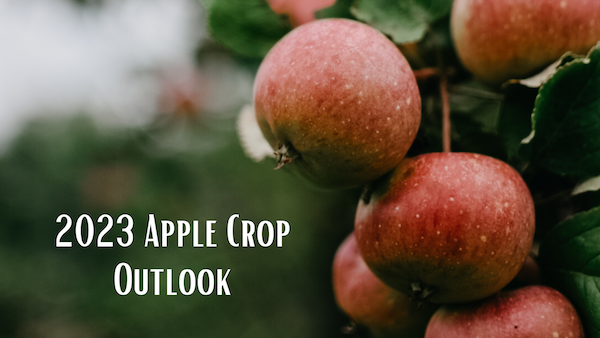
It’s time once again to share what we’ve heard from extension agents and orchardists around the country about this year’s apple crop outlook. Initial reports are from May-July of 2023.
Renae Moran, University of Maine
May 24: Temperatures were above normal going into winter, but no damage has been seen to occur from the midwinter low of -17 to -25 °F in early February. Reports from northern Maine are not yet available.
A warm spell in April caused an early start to the growing season, so green tip occurred about two weeks earlier than anticipated in southern Maine. Cool temperature followed this initial early start. Consequently, bloom occurred only one week earlier than anticipated. May 18, temperatures dropped to the lethal point during bloom and ranged from 24 to 30 °F depending on location within the state and orchard elevation. Higher elevations had better flower survival than lower spots. Western Maine had greater flower mortality, 90 to 100%, than eastern orchards, 10 to 20%.
Pollination conditions were fair, but the cool temperatures are expected to favor fruit set.
No major issues with disease or pests have occurred by this time of petal fall.
Sherif M. Sherif – Virginia Tech
June 1: The apple crop in Virginia for 2023 exhibited unique characteristics compared to previous years. One notable aspect was the early bloom, occurring approximately 10 days earlier than in 2022 and representing the earliest bloom in the past six years. This early development was likely influenced by the unusually warm winter experienced in the region. However, the early bloom was met with a series of frost events that had severe consequences for fruit trees across the state, including apples, peaches, cherries, apricots, and plums. The frost events occurred in March and April, with temperatures as low as 18°F recorded in some locations, including Winchester, VA. The damage caused by these freezing temperatures was significant, particularly affecting the apple cultivars that were transitioning from half-inch green to tight clusters. Observations collected after the first freeze on March 20th indicated severe damage to both king and side blooms, with an alarming 87% flower damage in king blooms and 60% damage in side blooms for popular varieties like Pink Lady and Gala.
Despite the detrimental effects of the frost events, the overall apple fruit crops for most cultivars in Virginia were not significantly impacted. In fact, fruit thinning applications were necessary in many parts of the state to optimize crop loads. However, the warm winter also resulted in sporadic blooming, extending over a prolonged period for certain cultivars that are not typically known for such blooming patterns, e.g. Gala. The sporadic blooming led to a unique situation where apple trees carried two distinct crops, differing in size by almost 9mm. This posed challenges for thinning decisions, particularly during the usual thinning window of 6-18mm.
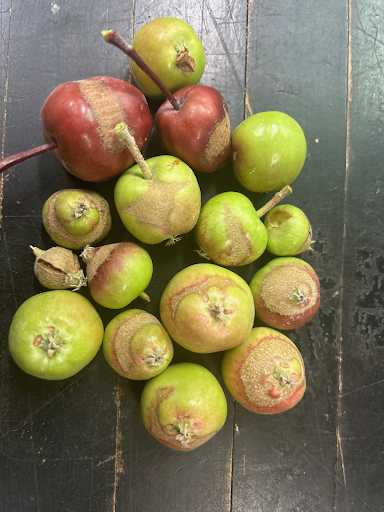
Despite the challenges posed by the frost events and the complexities in thinning decisions, it is anticipated that a full crop of apples will be achieved in most parts of Virginia. However, the quality of the fruit may be compromised in certain regions due to the frost damage (see picture attached for frost rings on apple fruits) and ineffective thinning practices. Nevertheless, operations that successfully implemented appropriate thinning strategies and employed hand thinning techniques are expected to yield above-average fruit size, particularly for cultivars like Gala, Pink Lady, and other small-sized varieties.
In conclusion, the 2023 apple crop season in Virginia was characterized by an early bloom, severe frost events, and sporadic blooming patterns. Despite the damage caused by frost, most apple cultivars are expected to produce a full crop, although fruit quality issues may arise in some areas. The challenges associated with thinning decisions due to the varying fruit sizes further added complexity to the season. However, growers who made effective thinning decisions and implemented appropriate techniques are likely to achieve above-average fruit size for specific cultivars, contributing to a successful apple crop in Virginia.
Nikki Rothwell – Michigan State University
June 22: The apple crop in Michigan is looking pretty good. We had good pollination weather, and although the winter was mild, we didn’t have any spring frost/freeze events that impacted the crop. We had good thinning weather, maybe a touch hot, but most growers had good thinning efficacy. We have been hot and dry, so growers without irrigation may struggle with fruit size. However, the weather is supposed to be cooler and have more moisture next week, so we have a long way to go to measure size. We had some cider varieties that had fire blight, more than I have seen in the past. Growers are pruning out the strikes and applying copper to keep the spread to a minimum.
Overall, growers are optimistic about apples in Michigan. We have the potential to have very high quality, and fungal disease pressure has been low because of the hot and dry weather. We are keeping an eye out for summer rots with the warm temperatures but have not seen any hint of those diseases thus far.
Jake Mann – Five Mile Orchards, California
June 27: The 2022 harvest was our biggest yet… great yield overall, and the addition of a new-to-us ranch with lots of McIntosh, Fuji, and Spitzenberg sent more fruit (and juice) to cideries throughout California. Our picking crew was fantastic, moving through the blocks quickly, while the weather remained agreeable through the fall. We seeded more acres in cover crop this year… the bell beans / vetch / peas germinated and were ready to take off when spring warmed up.
But before that… the rainfall this winter was massive. Maybe 150% of what used to be “normal” before all the drought years. We wore rubber boots for the Wassail party (not so common out here) You’ve likely seen the reports of devastation caused by flooding in nearby Pajero (a major farmworker housing community) here in Watsonville. Some corners of our orchards flooded, but fortunately drained quickly, hopefully avoiding long term damage to the trees (looks good so far). In between the storms, we accumulated plenty of chilling hours. All signs were pointing to a good year.
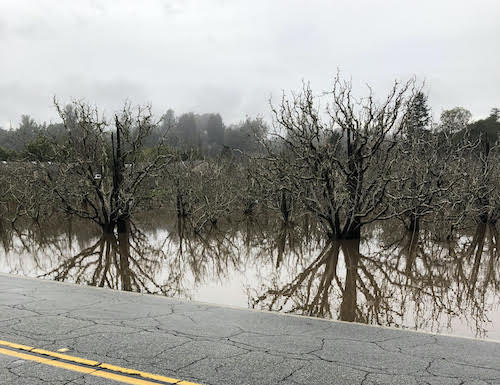
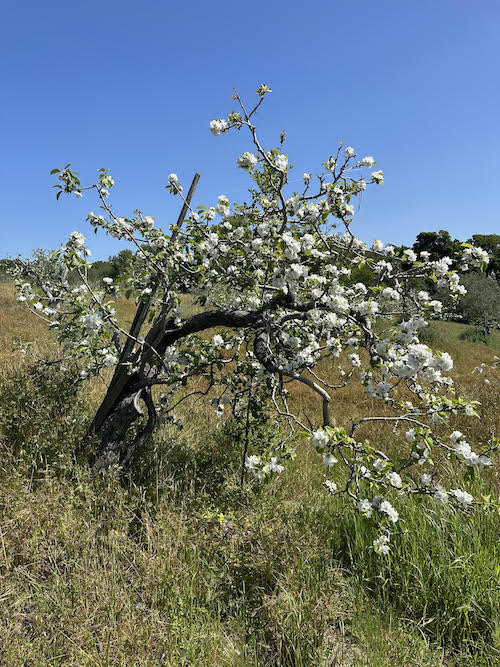
The bloom was promising in some blocks, a bit light in others. Bees were working during blossom time despite cooler temps, but as the petals fell and fruitlets started to stick, it became apparent we’re entering one of the lowest production years we’ve seen in a decade. Red Delicious (not something we use for our cider accounts) are very sparse (harvest strategy will have to be creative as our regular contract picking setup won’t pan out with the current density). McIntosh set is light but starting to size up. Pippins, Mutsu, and Fuji set is decent. Aphid has done a real number on the Granny Smith, unfortunately, and the cool temps seemed to keep lady bugs away in that crucial first week of activity. Starting to see new leaf growth beyond the aphid damage which is a relief. On a better note, the dry-farm Gravenstein orchard we take care of has the best set in the 4 years we’ve been working with it. (Good news for fans of Grav ciders).
We’ll be dialing back the irrigation efforts / hours this summer due to the accumulated rainfall. Hoping our mild, foggy weather keeps things mellow though the next couple months. Ripening is looking 2+ weeks later than normal.
Seth Brawner – WSU’s Northwestern Washington Research and Extension Center (NWREC)
April/May: This year in western Washington, spring weather was atypical – April was uncharacteristically cool and wet, while May was uncharacteristically warm and dry. Uncommonly, temperatures stayed almost completely below 60 °F until the end of April, when a heat event caused increasing temperatures (even briefly into the 70s °F) between April 27th and May 3rd. Yet overall, April was very cool. Olympia and Seattle experienced the coolest and second coolest Aprils, respectively, in the last 80 years. These low April temperatures seemed to have delayed bud development and, consequently, the date of full bloom. Hence, much of the orchard (planted with 65+ varieties) reached full bloom a little later this year, closer to mid-May rather than early May such as in the past. This will subsequently delay the time of harvest this Fall.
After an uncommonly cool April, the heat event in the beginning of May was followed by another period of cool temperatures that lasted until mid-May. These cool temperatures helped to prolong the blooming period. However, a higher heat event (high 80s °F) in mid-May and subsequent high temperatures in the latter half of May quickly reduced the effective bloom period. This May ended up being the second warmest May the Seattle area has experienced in the last 80 years. The abnormally cool, and then warm, temperatures this Spring have influenced and adjusted the full bloom date and bloom length this year. Due to the delay in bloom and subsequent high heat event which effectively ended the bloom period, these weather patterns may have a slight negative effect on pollination, fruit set, and final yields.
June: Now that we are almost into July, we can more clearly see what our crop outlook will be like this fall. While there is much variation within the orchard, this is generally the “off” year in the tree’s biennial cycle. Therefore, fruit set is relatively low compared to last season. Additionally, this year we saw the presence of tent caterpillars throughout the orchard; these pests were not present in the orchard last season. Some cultivars, those that are strongly biennial, have no fruit this season. The following list includes cultivars in which all 6 trees in the orchard had no fruit this season, or so few fruit as to be inconsequential: ‘Amere de Berthcourt’, ‘Brown Thorn’, ‘Brown’s Apple’, ‘Blanc Mollet’, ‘Breakwell Seedling’, ‘Bulmer’s Norman’, ‘Domaines’, ‘Ellis Bitter’, ‘Medaille D’Or’, ‘Mettais’, ‘Smith’s Cider’, ‘Sweet Coppin, and ‘Vilberie’. Popular cider cultivars such as ‘Golden Russet’, ‘Harrison’, ‘Hewes Virginia Crab’, ‘Kingston Black’, ‘Porter’s Perfection’, ‘Ashmead’s Kernal’, ‘Roxbury Russet’, and ‘Frequin Rouge’ all have a full apple crop load this season which needed to be thinned out. Although temperature and precipitation conditions this spring were not ideal, it seems that the apple crop load in our orchard was not severely affected. Looking forward to a great harvest this fall!
Greg Peck (Cornell University) and Scott Ramsey (New York Cider Association)
July 17: For cider apple growers in New York, 2023 was set up to be a banner year. Many orchards that had been planted over the past 10 years were finally expected to be in full production. Although the early parts of the 2022-2023 winter had above average temperatures, a relatively cold April held back bloom enough so that most regions in the state had fairly average full bloom dates. After Spongy moths, fire blight, and biennial bearing all coincided to reduce yields for many growers in 2021 and 2022, there was a tremendous bloom on cider apple trees in 2023.
Unfortunately, cold temperatures returned with a vengeance on 18 May. Most regions of the state experienced temperatures below freezing, with some locations getting into the mid-20’s. Trees in bloom or with small fruitlets experienced a range of damage from outright crop failure to varying levels of fruit loss and fruit peel damage. The damage was state-wide, but site specific. Orchards in close proximity to large bodies of water, such as Lake Ontario, one of the Finger Lakes, or the Hudson River, reported the least amount of damage. The 18 May event really drives home the importance of site selection in developing a sustainable cider apple orchard.
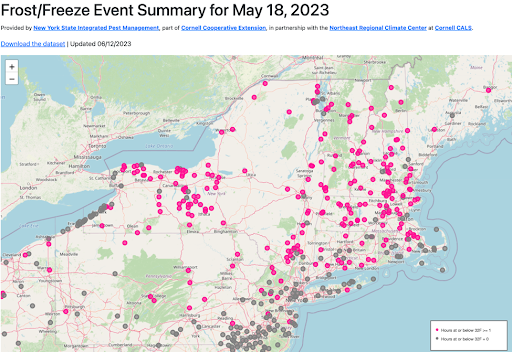
You can learn more about the frost/freeze event by visiting: https://data.nysipm.org/weather-events/20230518/map.html. This resource developed by Dan Olmstead who is the Project Lead for the Network for Environment and Weather Applications (NEWA), which is the regional mesonet system.
In response to the freeze events the New York Cider Association and Cornell co-hosted a listening session and are currently pursuing support for the cider industry through state and federal programs. Although it’s too early to fully get a sense of the varieties that fared better in the frost/freeze event, it does appear that some of the later blooming cider apples that had yet to bloom will have at least a partial crop.
To date, there hasn’t been a statewide survey for the apple industry at-large, much less for cider apple growers, there will still be many apples available for cider production. In fact, fresh-market apples that are unsellable through mainstream markets because of peel blemishes can still be used for cider production.
After the 18 May event, much of the state experienced dry conditions through the end of June, and then frequent precipitation occurred for the last few weeks. In mid-July, parts of the state experienced a “once in a thousand years” rain event that caused widespread damage to crops and infrastructure. It is too early to comment on the effects this will have on apple production, particularly in the Hudson River Valley where 8 inches of rain was reported in just six hours.
Additionally, smoke from fires in Quebec, British Columbia, and elsewhere have caused repeated air quality issues in New York. Although there might be some reduction in photosynthesis from the smoke, there should be minimal impact on apple productivity or fruit quality. However, the smoke is a significant health hazard for farm workers.
Despite the hardship that these weather and largely climate change driven events have on individual farms and cider producers, there are many producers in the state that have reported having minimal damage. In particular, growers close to Lake Ontario, one of Finger Lakes, or the Hudson River Valley have so far been spared significant crop damage. Even though crop yields and cider production will be down this year, we are hopeful that 2023 will produce some excellent New York ciders.
Megan Muehlbauer – Rutgers University
July 31: The 2023 growing season has been very variable across New Jersey. A late season frost caused extensive damage to the apple crop in the Northern half of the state. However, many growers unaffected by the frost are anticipating a bumper crop.
The season kicked off with very little rain, and by mid summer the state had a number of heavy rain events.
Thus far diseases have been minimal or well controlled.
2022 Apple Crop Outlook
It’s time once again to share what we’ve heard from extension agents and orchardists around the country about this year’s apple crop. Initial reports were taken in April with a follow-up from some folks in June.
Dr. Nikki Rothwell – Michigan State University Extension
April 27: We have had a slow start to spring here in Michigan, which many growers prefer compared to the wild seasons we have had in the recent past. Trees are waking up slowly, and we are gaining growing degree days at a limited rate. The seasons where we see large swings between early warm ups followed by drastic drops in temperatures are much more concerning with the apple crop. Growers are still pruning, bucking brush, and waiting for warmer weather. Some growers in the southern part of the state have made copper applications with the warm weather over the past weekend (23-24 April). We have also had much more rainfall than our typical early springs, so growers have not been as active within the orchard with the wet soils. According to our MSU Climatologist, more wet and cooler weather are in the forecast through the middle part of May. Thus far, have not seen any frost events that would be greatly reducing the crop. There is a cold overnight predicted tonight (27 April), but most temperatures are not going to be so cold as to damage flower blossoms. We will continue to keep an eye on the weather throughout the spring.
The current apple crop in Michigan is looking good at this time. However, as growers know, there is a long way to go until harvest. Our fellow growers in Utah and Washington state have provided reports of cold weather and snow, but no official estimates are out yet. The demand for apple fruit across the U.S. is likely to be good, particularly with the ongoing situation in Ukraine and Russia. One of the major issues is availability of fertilizers this spring. Again, the conflict in eastern Europe has disrupted the nitrogen supplies, and both Russia and Belarus are the second and third largest producers of potash. In addition to fertilizer shortages, there are transportation issues, which may disrupt the availability of both raw and finished products. There have even been reports of chemical container cap shortages! We are recommending that growers worth with their agrichemical representatives to secure products that will need this season. With the cold weather, insects and disease pressure has been low. However, if the predictions are correct and wetter weather will continue to be around this season, we may see increased amounts of pests and diseases.
June 16 Update: I can add that we had very cool conditions during thinning, so we may have to do some hand thinning later this season. The overall apple crop looks good, and we have had some well timed rains that have helped out a lot. Despite the relatively dry weather, we are starting to see apple scab show up. Not a lot of fireblight with the cool weather at bloom.
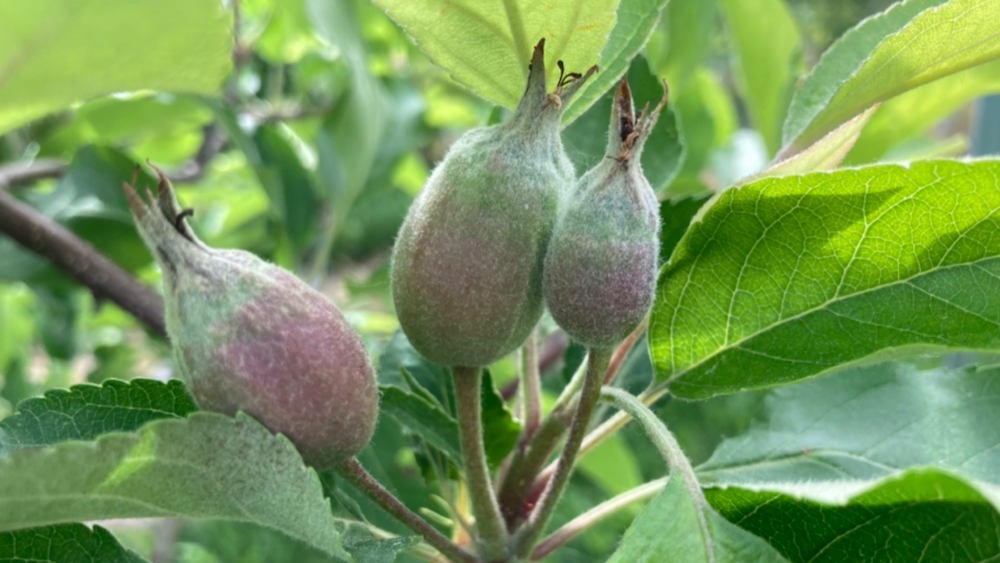
Katrina Mendrey & Zachariah Miller – Montana State University Western Agricultural Research Center
April 27: Trees are just starting to wake up across Montana. Many trees are still recovering from our big freeze in October 2020, so we expect a light crop in cultivars like Marie Menard, Major, Golden Russet and Harrison. The cold hardier cultivars like Hewes Virginia Crab, Binet Rouge and Muscadette de Dieppe are looking great after a relatively mild winter. We have had a slightly cooler spring than usual, but this may have been to our advantage as we had temps as low as 10F on 4/13/22 at the Western Ag Research Center in Corvallis, MT. At the station most of the trees were still in silver tip except for the HVC, Wickson and Chestnut crabapples which were all approaching tight cluster. We have seen about 20% damage to the king blossom in Hewes Virginia Crab, but little damage otherwise. Just nature helping us thin!
June 20: The cider trees at the station seem to have come through the spring cold just fine. There’s the typical variation in crop load with alternate baring, but there were dense blooms on the trees that are in a bearing year. For the later blooming cultivars, the weather was hot during bloom and that elevated the risk of fireblight. The MT growers that I talked to were managing fireblight well. We’ll see the impact on production over the next few weeks.
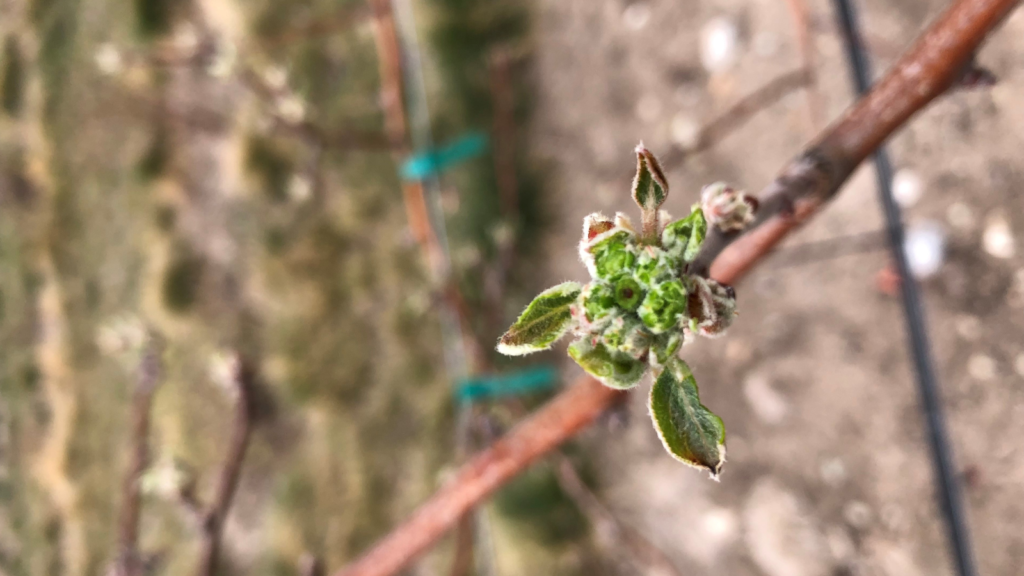
Greg Peck – Cornell University
New York had a fairly average winter with cold temperatures that extended into the spring. Bloom dates in the central and northern parts of the State were inline with long-term averages. There were no major spring frost events in New York’s main apple growing regions. However, there were several days during bloom when temperatures were exceptionally warm (>85 ºF), providing excellent pollination conditions. Immediately after bloom many growers were feeling very optimistic about the crop. However, those warm days allowed for the bacteria that causes fire blight to rapidly multiply and many cider apple growers have since reported that they have a considerable amount of fire blight infections in their trees. This is despite the fact that there were minimal precipitation events, which is usually needed to cause a fire blight infection. The fire blight outbreak has spared many farms around the State, but I’ve heard reports of fire blight in every region. For those with infected trees, the damage is considerable. Both organically and conventionally managed orchards are affected this year, showing the difficulty in managing this lethal disease. At Cornell’s research orchard in Ithaca, as well as many other farms in New York, we now have streptomycin resistant strains of Erwinia amylovora (the bacteria that causes fire blight). This means that streptomycin, the predominant antibiotic that is used to prevent fire blight, is no longer effective. Streptomycin resistant Erwinia strains had already become common in Washington and Michigan, but had previously only been found on a few farms in New York. I suspect that these resistant strains are becoming more commonplace in New York and are in part the cause of the 2022 outbreak.
The early part of the growing season was exceptionally conducive to plant growth. There was plenty of soil moisture from the excessive precipitation received in 2021 combined with warm temperatures. These conditions exacerbated the fire blight infections in many trees. For those farms that weren’t battling fire blight, the early season was idyllic. Apple scab, which is the most economically important fungal disease in this region, was very manageable and I have seen very few infections in either conventional or organic orchards. Last year’s extreme rain events have become a distant memory, as many parts of New York head into drought conditions. Without additional rainfall, orchards in New York can expect smaller than usual fruit. However, this may also result in higher sugar contents in the juice, similar to what New York experienced in 2020. Going from extreme precipitation in one year to drought the next has been a predicted result of climate change in our region. These predictions are now a reality as apple growers must manage producing apples with both too much and too little water.
With the exception of farms that have suffered fire blight infections, I suspect that New York’s apple crop will be near to average in volume. High tannin cider apples are still in short supply as they are not widely grown yet, but there should be plenty of apples overall.
Jake Mann – 5 Mile Orchards, Corralitos, California
June 21: The 2021 harvest was a light one. Not surprising, as we were overdue for a biennial down year after great yields in 2018/2019/2020. When we closed up the cold storage after picking Granny Smith (the last variety harvested), the large rooms were definitely not full to the doors as in years past. Though we had more robust sales in-season to cideries and fresh market, there was no denying it had been a lean year. Our extra irrigation through summer did help size-up the fruit that had set (we normally only irrigate once), and pickers were still able to place their ladders and fill bins quickly. Many cheers to our great team of foremen/women, ace mechanic, cold storage maintenance gurus, neighboring apple growers, and the community that supports our care of these remaining apple forests while providing fruit and juice to folks across the state.
Fast forward to June of 2022 and my current mantra is “Always. Be. Thinning.” The trees are loaded, and I can’t be anywhere near one without popping extra fruit off the clusters that are weighing down branches. Spring’s unreal bloom turned into a heavy fruit set. We dodged frosts, hail, and any excessive warm rains that would promote scab growth. Evidence of insect pests is minimal so far. Always keeping an eye out, ready to react, but also observing how our continued customs of orchard management are keeping this fruiting ecosystem in balance.
We accumulated a normal / minimum requirement of chilling hours and precipitation over the winter. Irrigations began in early June, starting with a newly-leased organic orchard that has a nice block of McIntosh (an uncommon variety here) all on semi-dwarf, tightly planted, ladder-free, short trees. (A fresh “rompecabezas” (“head-breaker”) …a term our foremen use when referring to the puzzles of a new orchard.) We’ll move into the giant seedling rootstock Newtown Pippins with 30’ sprinkler pipe at the beginning of July for their annual deep watering from shared wells in the neighborhood.
Gravensteins are starting to show stripes and are pushing off their “June drops”. I caught the first whiff of a ripening apple on the ground this week. Overwhelming, and quickens the pace toward the first harvests that will begin in less than 2 months. Fingers crossed, we might need all the bins this year.

Renae Moran – University of Maine
June 16: Conditions for apples in general are good in Maine. In the southern half of the state, bloom occurred with higher than normal temperatures and good pollination conditions. This was followed by cold temperatures during the thinning window. Many orchards had excessive fruit set, so I was worried about getting good thinning during the prolonged cold weather. Orchards at the Highmoor Farm experiment station are starting to show effective chemical thinning. In the north, pollination conditions were less favorable with cool temperatures and wind. Fruit set appears to be adequate in orchards in the central part of the state.
Fireblight seems less problematic than in past years. Weather during the regular bloom time was drier than normal. Late blooming cider varieties may show signs of fireblight since rain was more frequent during their bloom phase. Bloom sprays of streptomycin or other antibiotics is now routine for most growers, so I expect fireblight to remain under control.
Marcus Robert – Tieton Cider Works
June 15: In Central Washington late frost events and recent wind and rain conditions has adversely affected the crop volume. Overall stone fruit crop will be down substantially from previous years. The apple crop will also be lower than previous years. Biennial bearing trees have shown lowered return bloom and hail events in the northern area has decreased the crop. Pears seem to be holding their own so far. They have made it through the worst of the cold and crop load seems to be average.
Megan Muehlbauer – Rutgers University
June 15: New Jersey has had several frost events early in the spring that have cause significant fruit loss in early/mid-blooming varieties. Of the varieties that made it to full bloom, most of them had a very protracted full bloom (1-2 weeks). In general, the later blooming hard cider varieties have made it through the spring without damage and the crop outlook looks good. In terms of disease, some apple scab has been observed on several of the hard cider varieties in the Rutgers University variety trial (Pittstown, NJ) this year.
Dr. Chris Gottschalk – USDA ARS, Appalachian Fruit Research Station
May 16: The growing season for 2022 is off to an exciting and nerve-racking start at the Appalachian Fruit Research Station (AFRS) in Kearneysville, WV. Bloom kicked off with the majority of pear varieties entering full bloom during the week of April 11th. Unfortunately, a chilly overnight temperature of 21˚F was observed on March 29th. The cold temperatures resulted in an estimated 50% blossom death to the most advanced pear varieties (Fig. 1). Mid- to late-blooming pear varieties survived the night with potentially minimal loss of 20% or less of blossoms. Wild apple species, interspecific hybrids, and cultivated varieties began to bloom during the week of April 18th. Traditionally, apple bloom at the station during the first week of May. We are about one week ahead of schedule for historic apple bloom dates in our area. The apples also did not sustain any damage due to the cold temperatures in late March as their development is delayed compared to pear. Pollinators, especially native bee species such as Blue Orchard Bee (Osmia lignaria), have been abundant and active this season. Pears are beginning to display signs of fruit set with fruitlets starting to appear and apples are at anthesis during the week of April 25th. We are anticipating average to high yields for both crops at AFRS.
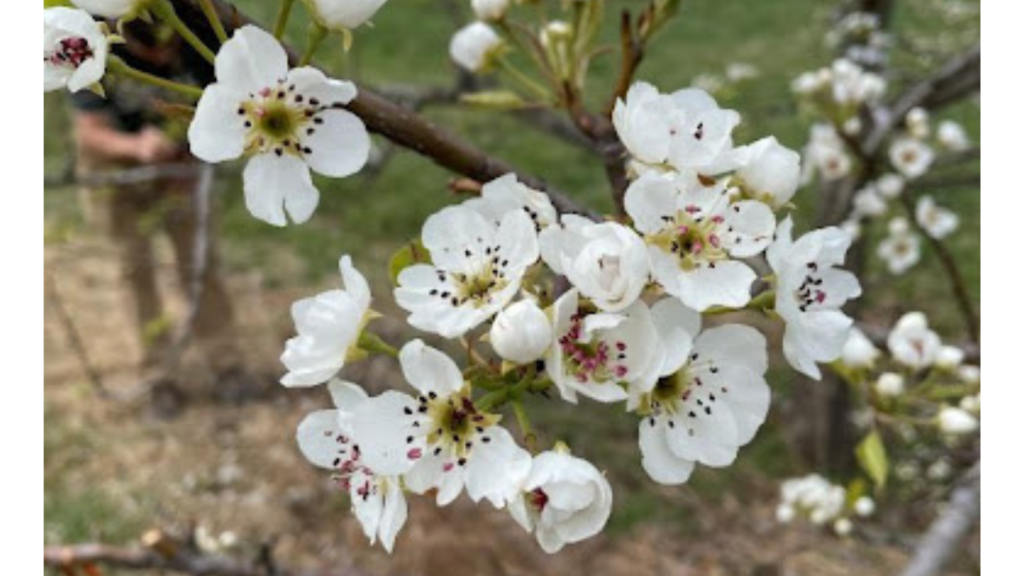
Nik Wiman – Oregon State University
April 22: We have had a very cool spring with one of the wettest Aprils on record so far. We had a rare snow in early April and some unseasonably cold temperatures throughout the month. At the North Willamette research and Extension Center in Aurora OR where our research cider apples are located we had multiple days with below freezing temperatures and a low temperature of 28 F, but we have not seen much damage to apple bloom. We anticipate good fruit set and ample soil moisture going into the growing season. We have had almost 5 inches of rain in April through the 22nd, so we are a bit concerned that there has not been a lot of time for the bees to work. Just short windows between the rain storms and cold temperatures. Probably the late blooming varieties will fare better than the early bloomers this season.
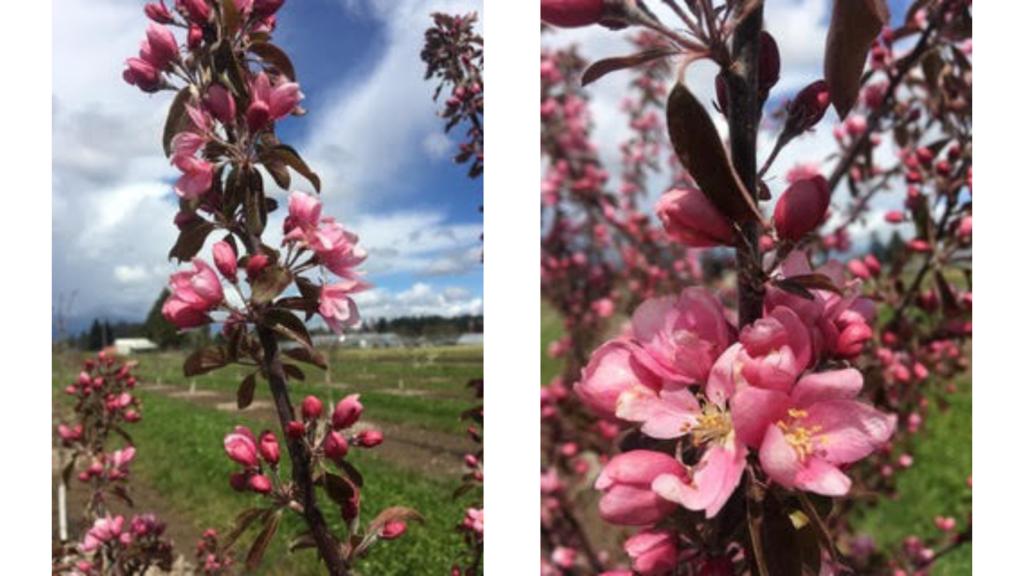
ACA Receives Grant for “Year of the Apple” in Virginia
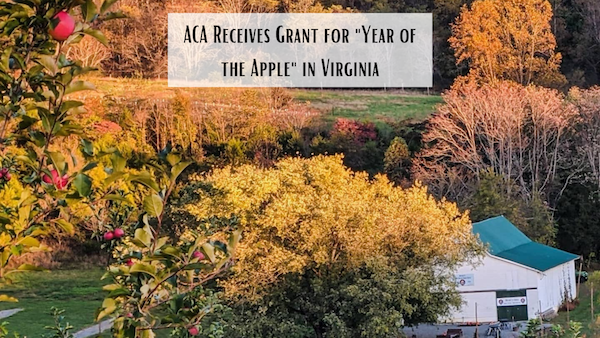
The American Cider Association is proud to announce a new partnership with the Virginia Department of Agriculture and Consumer Services through a USDA Specialty Crop Block Grant awarded for $70,012. Starting in early 2022, the American Cider Association (ACA) and their partners in Virginia cidermaking and agriculture will launch “The Year of The Apple,” an integrated public awareness, food industry professional outreach and market research campaign.
Virginia is the country’s 6th largest producer of apples and home to 48 independent cider makers, from the celebration-worthy bottles to adventure-ready cans. Virginia also boasts perhaps the longest and most storied history of cidermaking in North America, with apple orchards that date back to the 1600s. Yet both the restaurants and food lovers of Virginia don’t choose home-grown cider enough—Virginia has lower sales-per-capita than other cider making states.
Virginia Association of Cider Makers President Anne Shelton is excited about the opportunity the grant may bring. “Our state has a bountiful array of homegrown apple varieties, a deep history of cidermaking, and a super talented community of cidermakers crafting a wide variety of styles. We hope this grant can increase awareness around this with consumers and buyers and promote Virginia apples.”
In addition to creating awareness and understanding around Virginia cider, the grant will pay for survey research to learn more about the supply of the unique mix of apples that grow best as well as more about the state of the cider industry in Virginia.
From Shenandoah peaks to gentle ocean beaches, Virginia is home to a uniquely American diversity of landscapes, people, and ciders. “With just a little reminding, I think the drinkers of Virginia are ready to embrace the diversity and deliciousness of our uniquely Virginian ciders,” says ACA member Courtney Mailey of Blue Bee Cider in Richmond.
2021 Apple Crop Outlook
We reached out to extension agents and orchardists around the country to hear what they had to say about the progression of the 2021 apple crop around the United States. Here’s what they had to say.
Aidan Kendall, Mt. Vernon Northwest Washington Research and Extension Center, Mt. Vernon, WA
The cider apple research orchard at WSU NWREC consists of 65 different cultivars grafted onto Geneva 935 rootstock, and 4 cultivars grafted onto Geneva 202. Our apples are being managed with a conventional pesticide rotation. Apple anthracnose is present, though largely kept under control with the removal of contaminated wood. This year many of our cultivars are bearing little to no fruit as a result of a heavy crop in 2020, though what flowered was pollinated successfully by a new on-site hive. The heat wave brought sunburn to some cultivars with heavily exposed fruit, mostly in the border rows. We are grateful for healthy trees and as always, excited for this year’s harvest.
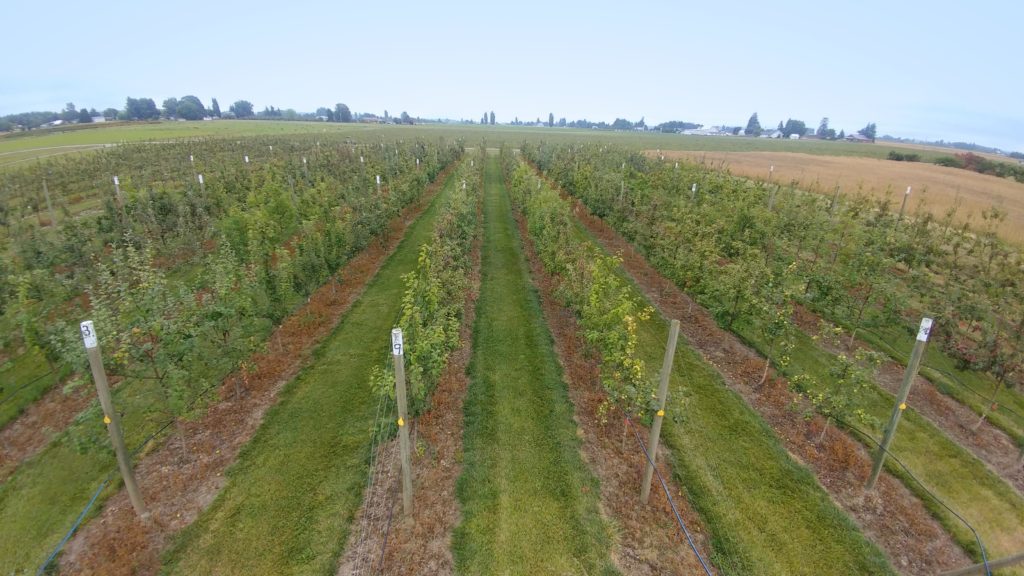
Jake Mann, The Five Mile Orchard, Pajaro Valley, CA
The 2020 harvest came on quickly after the heatwaves of August ripened the apples faster than expected. Our crews were helpful in sorting out sunburnt fruit while picking, and the sound crop stored well in our coolers. Wildfire smoke was an added challenge to harvest logistics, ending some picking days early even though the N95 masks provided by our County Agricultural Commissioner were very helpful to all involved. Apples do not pick up smoke taint, and so we were able to avoid the moral and financial quandary that the wine industry faces in these events. We simply wait until the next reasonable day to continue picking.
It was a dry winter. Pruning work was completed quickly in December and January thanks to no weather delays. Dormant sprays went on without difficulty. We received the most chilling hours seen here in 25-30 years… between 600 and 800, much more than needed to reset our trees. The bloom looked good, and there were no rain events during that time (and so, minimal apple scab events necessitating fungicide sprays beyond our regular applications) As we moved into May, it became apparent that fruit set was light across the Pajaro Valley. Looking back on cold days during bloom, a couple localized morning hail storms, and the possibility of a down year in what remains of a biennial bearing cycle (after 3 good harvests in 2018/2019/2020) has all the growers speculating about what happened, how harvest plans and crop projections will be adjusted. Some of our bonus varieties like Jonagold and Granny Smith (usually reliable croppers) are very light this year. Most of our Newtown Pippin blocks have an acceptable crop developing, and the Red Delicious and Fujis are looking decent enough to sustain a picking crew through harvest.
California is now in another historic drought and we are upping our irrigation plan for this season. We operate with temporary installations of 6″ mainline and 3″ sprinkler pipe, hooking up to shared wells as they’re available through a given week. Usually only applied once in July, we opted for an additional, early round in May that has given the crop a helpful boost going into the big growing days of summer.
Orchard work happens outside, and the folks in our crew remained healthy during the pandemic, save for one core personality, Don Pablo, who passed in January after battling COVID in the hospital for a month. His loss was a real blow to the spirit of the extended family who works to keep these local orchards rolling year after year. The mobilization by our County to get vaccines specifically to the agricultural community in February and March was such a relief, and recognition of support, for the hard working people in our corner of the State.
I’m thankful for the apples we have growing, on ranches that’ve been under our care for years, showing the wisdom and skill of our team, and diligent, iterative improvements to the process year after year as we work with this 100+ year old system. Always something new to adapt to and improve upon. Our connections with the cider industry continue to grow, and it’s a real high point in my year to see how the fruit we produce is being elevated to such a nuanced, geographically representative, and historically significant beverage by the talented cider makers we have the fortune of working with here on the West Coast.

Greg Peck, Cornell University, Ithaca, NY
Crop conditions in Central NY look very good for most of the cider apple orchards. An early budbreak led to quite a bit of anxiety that we’d lose the entire crop to spring frosts. Luckily, the late blooming European cider varieties dodged the worst of the frosts and trees that are in their “on-year” were able to set a full crop. We’ve gotten plenty of rainfall in Central New York, so as we enter into July the fruit is sizing up quickly. Fireblight continues to be a major concern for cider apple orchards in NY. At our research farm in Ithaca, we had a bit of new infection through this year’s flowers despite a very aggressive anti-biotic spray program. We are also seeing fireblight show up in trees that were infected last year when we had a severe outbreak. We’ve applied pro-hexadoine three times this year, as well as adding a low rate of copper to our cover sprays. We also prune out symptomatic branches and sometimes whole trees at least once a week. The late blooming cider apple varieties might avoid spring frost damage, but they are extremely susceptible to fire blight infections during those warm and rainy spring days.
Megan Muehlbauer, Rutgers University, Snyder Research and Extension Farm in Pittstown, New Jersey
The weather in New Jersey was favorable in the spring for adequate pollination of apple flowers. Thus far the crop loads are looking good. Some thinning was required for a few varieties that had excessive fruit set.
In orchards where regular spray schedules were followed there was minimal disease pressure. This was due in part to the fairly dry weather observed in New Jersey from early spring up until present. Insect pressure has been light with the exception of the severe cicada brood X damage. Cicadas have been particularly destructive in the central portion of the state. They first emerged at the beginning of June and the populations are only just beginning to dwindle. Significant flagging of young shoots of apple trees can be seen in orchards throughout the state.

Elizabeth Garofalo, UMass Extension Fruit Program, Belchertown, MA
“Abnormally dry” conditions set in in MA on March 9, according to the U.S. Drought Monitor. These conditions persisted, reaching their worst during the week of April 27 when 20% of the state was experiencing “moderate drought” conditions. At the UMass Cold Spring Orchard in Belchertown, MA water deficits began to improve when a three-day event dropped ~2” of rain. While drought conditions in Belchertown have since abated, the site continues to receive below historical average amounts of rain as of July 1, 2021.
Temperatures in Belchertown during spring months (March-May) were overall warmer than average. On March 12, temperatures reached record highs and four days later, temperatures plummeted reaching record lows. In addition to abnormal, and wildly fluctuating, temperature patterns, nearly a foot of snow fell at Cold Spring Orchard on April 16.
With a drought on through much of the spring, you’d think that disease management would be a breeze. And when it comes to apple scab, you’d be right. With the exception of a few locations which had some extenuating circumstances, the primary scab season was managed readily. In fact, RIMpro logged only four primary infection events for the season (4/29, 5/4, 5/27 & 5/30). The severity of each event was estimated to be in the extreme, however and growers still had to be on their guard.
Long stretches of dry weather in early spring can often indicate an opportunity for reduced fungicide application. This may have been one cause of an increase in powdery mildew (PM) infections seen broadly across the state this year. Many growers have spent more time cutting out PM infested shoots than they did fireblight… Well, until recently that is. Fireblight during bloom was of relatively low concern in Belchertown (we all know fireblight is never of no concern!). Temperatures around bloom remained relatively cool. In fact there was some concern around pollination due to unfavorable bee conditions. However, as UMass’ Jon Clements reported, this year was “as close to a snowball bloom across the board as I have seen in awhile”. We managed to make it through with good fruit set and even squeaked out decent thinning weather although it was touch and go for a little while.
While blossom (fire)blight was not seen much, shoot blights began to show up in late June. Typically, we see this phase manifest later, in early to mid- July. Which, in the timeline of this season brings me too today. As I look out my window, all I can think is “Ouch, bitter rot must be having a field day out there right now”. Climatic conditions for infection initiation are ripe for bitter rot development. We will be keeping a close watch out there for this disease. Over the last few years, we have seen bitter rot cropping up more and more, even though in the past we have traditionally thought of it as a “southern disease”.
While insects aren’t my forte, per se, I can tell you this: we have seen more rosy apple aphid outbreaks across MA this year than we have in recent past. Unfortunately, once you have observed the characteristic leaf curl, it is too late to make an effective insecticide application. We expect to see more deformed, stunted fruit at harvest this year than usual, although, hopefully, not too much. Another interesting if unsettling development in the world of crawlies this year is the early capture of brown marmorated stink bug (BMSB). Typically, in MA, we do not catch this pest in our traps until later in the summer. This year our resident entomologist Dr. Jaime Piñero and his team of graduate students observed the first BMSB in traps the week of May 24 in 5 of 13 locations where traps were set out with a high count of 14.
It seems our warmer than average seasonal temperatures are making certain insect and pathogen pests happy, while vexing us.
Update: As of August 4, Belchertown, MA has exceeded average annual precipitation by more than 3” and Greenfield MA has seen more than 6” above annual average precipitation. If we continue to experience above average rainfall, sugar concentrations in apples could decline.
Amy Dunbar-Wallis, Boulder Apple Tree Project, Boulder, Colorado
After two very disappointing apple-yield years in Boulder County, Colorado, the 2021 crop is looking promising. In 2020, a late frost and snow impacted budburst and pollination so we had very few apples. This year, we have experienced higher than average precipitation with relatively mild temperatures. Undergraduate students involved with the Boulder Apple Tree Project have reported trees with many small apples forming throughout the canopy while out mapping historic trees. Fire blight and codling moths continue to be an issue for apple tree growers. We are optimistic that this will be an excellent year for apple yield.
Nik Wiman, Oregon State University, Corvallis, Oregon
We are in a severe drought here in the Willamette Valley. Regardless, our apple crop in the cider orchard is really great this year. We were a bit overcropped as the fruit set was very high. We have been thinning aggressively because our trees can’t support the fruit load yet. We had an unusual dry spring, so we are anticipating low disease pressure from apple scab, which can be pretty ferocious here in a normal year. Codling moth pressure is always high, and we are anticipating lots of pressure from borers, both flatheaded borers, which thrive on drought-stressed trees, and ambrosia beetles which seem to be ever-present. We hope the heat will not negatively impact fruit quality. We should have fruit available for purchase this year, and we are hoping to have an open-house at our cider orchard this year.
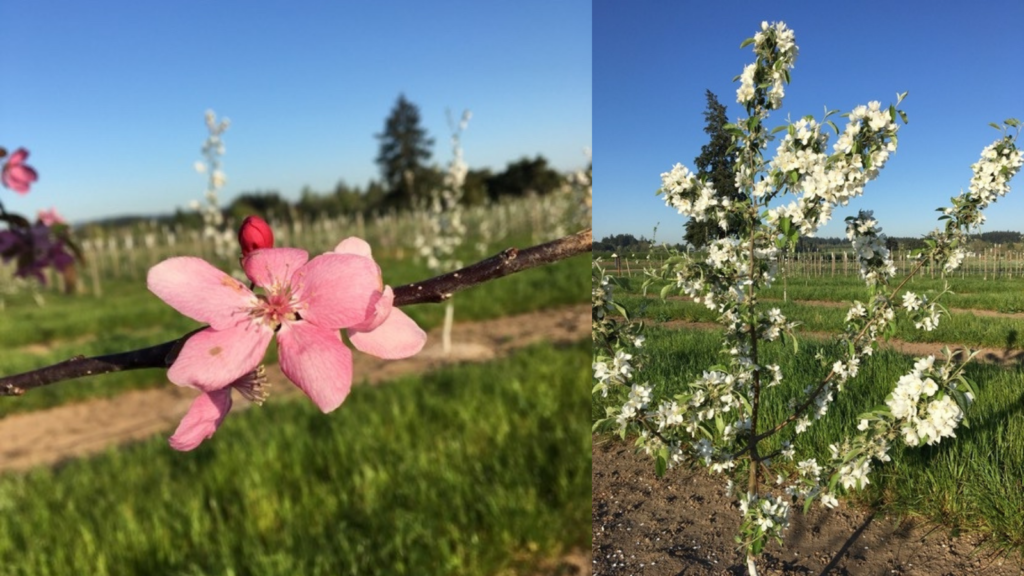
Thomas Kon, NC State Mountain Horticultural Crops Research and Extension Center, Mills River, North Carolina
Spring 2021 was not kind to southeastern apple growers (NC, SC, and GA). A pair of cold nights at pink bud stage caused some bud mortality, which resulted in a reduction in crop potential at some locations. When at petal fall, we observed 25 to 26 F at several locations, and many sites were below freezing for multiple hours. The result is widespread and significant crop damage/loss, with a few exceptions. Unfortunately, 2021 will be a difficult year for much of the southeastern apple industry.
Nikki Rothwell, MSU Extension, Traverse City, Michigan
We have a good crop of apples in NW Michigan. The crop is a bit lighter in our main apple growing region on the Ridge (just north of Grand Rapids). We have had some issues with fire blight this season, and I have also seen more scab than I would like to see so early in the season. The NW region of the state had some bad hail, but as always with hail, it is isolated–some orchards got lucky while others did not. The insect front has been slow with the cool weather early followed by the super hot, but I suscept with the rains, they will start to become more of an issue. Some areas of MIchigan received over 6″ of rain on the 24-28 June rain event. This humidity and wet conditions will also foster disease development if growers did not control primary scab.
Katrina Mendrey, Western Agricultural Research Center, Corvallis, Montana
The fall of 2020 has had a huge impact on cider apple production in the Intermountain West with several cultivars, in particular when trees are under five years, being severely damaged or killed by a sudden drop in temperatures in late October. Some of the cultivars that were severely damaged include Dabinette, Chisel Jersey, Roxbury Russet, Golden Russet and Ashmaed’s Kernel. The degree of damage was variable though based on location and the age of trees and a full report can be found here. For cultivars that came out of the winter undamaged, including Hewe’s Virginia Crab, Binet Rouge, Tom Putt, Muscadtte de Dieppe and Wickson, we’ve had good pollination and fruit set. Fire blight danger was high throughout bloom as usual. Whether trees made it through the high risk period uninfected largely will depend on grower control with effective sprays. So far we haven’t had any reports of damage and have been scouting several orchards for samples to include in a research study on antibiotic resistance in Montana fire blight.
Sherif M Sherif, AHS Jr. Agricultural Research and Extension Center, Winchester, Virginia
Our digital temperature data loggers placed in four different blocks in the AHS Jr. AREC’s research farm, Winchester, VA indicated that we were hit by killing freezing temperatures in the mornings of Friday (April 2) and Saturday (April 3), with the latter being more aggressive and long-lasting. In fact, the lowest we received on Friday was 24oF, but on Saturday, our trees were hammered by temps as low as 21oF for more than 30 min. 21 oF for 30 min or more are enough to kill 90% of apple flower buds at ‘tight cluster’, ‘first pink’ and ‘full pink’. On April 5, we collected flower clusters from Gala, Fuji, Pink Lady, Red Delicious, Zester, and Honeycrisp. Except for Zester, all the cultivars were only moving from ‘tight cluster’ to ‘first pink’. Zestar with flowers at ‘full pink’ showed 65% mortality. Other cultivars showed 45% (Fuji), 45% (Gala), 42% (Pink Lady), 15% (Red Delicious) and 5% (Honeycrisp). Unsurprisingly, king blossoms showed far more damage than side flowers. That being said, I would say that most Virginia growers, especially those in northern and central parts of the state, will achieve almost full-crop at harvest for apples. Growers insouthwest Virginia indicated that their apple orchards were hit hard by frost and they don’t expect an economic crop this year.
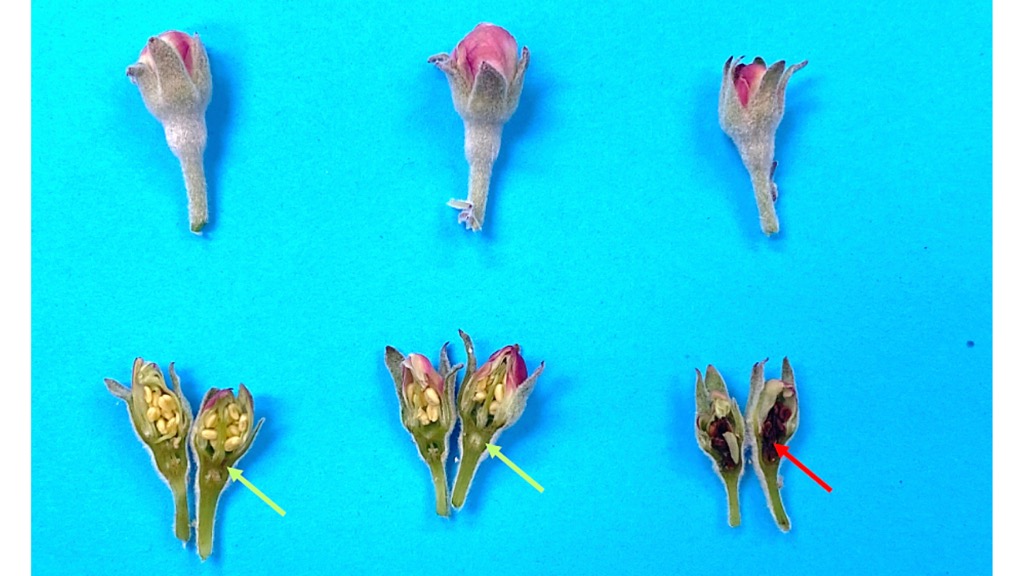
Photos from VA Tech AHS Jr. Agricultural Research and Extension Center
Renae Moran, University of Maine Highmoor Farm, Monmouth, Maine
Spring 2021 weather conditions were favorable for a heavy fruit set. Freezes occurred when trees were still at half-inch-green or tight cluster, so Maine has not had any cold temperature damage as far as I know. Some regions of the state had a very light crop last year and may be set up for biennial bearing, but hopefully, I am wrong. We had abundant bloom and good pollination, so we could be in for an excessive crop. As of May 26, most growers have applied a chemical thinner with favorable weather for good effectiveness. Last year, several growers in the southern part of the state had fireblight outbreaks, and late blooming cider varieties were particularly hard hit. As we progress through the fruit set stage, the lack of sufficient rainfall has many of us worried about another prolonged drought, but it could lessen the chance for more fireblight. Best of luck this season to all apple growers.

Cornell Cider Supply Chain Survey
David Zakalik, a grad student under Greg Peck, has developed a survey to assess cider supply chains across North America. He is asking for the help of ACA members to take the survey to create a larger base from which to glean information. Please read below for the description of the survey from David and to find the link to the survey form.
The Peck Lab Group at Cornell University has been collecting data from cidermakers across North America about apple supply, what varieties folks are fermenting/growing, and how apple supply affects cider style. We’re doing one final push for responses (180 and counting so far) from all sizes and styles of commercial cideries. We would greatly appreciate your participation to help us understand how what we’re researching affects the cider industry.
The more responses, the more representative the results will be of the industry as a whole. If you’d like your cidery’s needs to be heard by researchers, please take a few minutes to fill out this Google Questionnaire. All info will be anonymized; a report will be coming out later this year. Responses will be accepted through May 15th.
Please direct any questions to David Zakalik at dlz27@cornell.edu. Thanks in advance!
5 Things to Consider before Using Ground-Harvested Apples for Cider
By Bri Valliere, Fermentability Consulting & Education

While the fruit this time of year begins to disappear from tree branches, there still may be plenty on the ground. Before you pluck up those apples and throw them into the press, you should know some of the basics of turning these ground-dwellers into your favorite drink.
- Regulations & Food Safety
Make sure you know what’s legally allowed and not allowed in your country. In the U.S., growers must follow the Food Safety Modernization Act’s Produce Safety Rule. The Produce Safety Rule clearly states that covered produce – including apples – may not be used for human consumption unless it has undergone sufficient processing to eliminate food safety concerns. Fortunately, there are many steps that both apple growers and cidermakers can take to ensure safe practices and products when using ground-harvested fruit for cider. One of the best steps is fermentation, as high ethanol concentrations and the low pH of the cider together help eliminate human pathogens.
2. Method of Harvest
Gathering the fruit from the ground needs to happen relatively quickly to prevent further rot or animal scavenging. The quickest, most efficient way to scoop up your apples is to use a mechanical sweeper on your orchard floor, though this may be a major capital investment. The other option is to pick up the fruit manually. Regardless of if you’re using machine power or human power, make sure you’re able to get there soon after the apple meets the earth.
3. Immediate Sorting and Processing
One of the downfalls of windfalls is that the fruit can get bruised and beaten on its journey from the branch to the ground. While apples can usually be stored for weeks or months before processing (depending on the fruit maturity at harvest), ground-harvested fruit may quickly begin to rot and must therefore be processed immediately. Make sure that you also sort out any “bad apples” before crushing and pressing. Also, mature apples can be softer than their earlier-harvested counterparts, so be sure to build in some extra time for troubleshooting your crushing and pressing operations.
4. Cidermaking and Fermentation
Apples fall from the trees when they’re ripe, so ground-harvested fruit may have more sugar (and therefore a higher alcohol potential) than when fruit is harvested and processed earlier in the season. The presence of fruit rot may also result in higher levels of acetaldehyde, a compound that affects SO2 binding. If molds take hold, they can raise the pH, so it’s extra important to sort out rotten fruit and make pH adjustments if necessary. You might also notice different flavors and sensory characteristics!
5. Sustainability
Cider business owners must always be aware of their triple bottom line (profits, planet, people). Using dropped apples may be good for the planet by reducing food waste and for your business by making full use of available resources. However, will your employees develop injuries from bending down to pick up apples repeatedly? Will you lose significant time (and therefore money) if you have to stop frequently to clean out the gummy apples from the crusher? What additional steps will you need to take to ensure your product truly is safe from foodborne pathogens, and what will they cost? Make sure your use of ground-harvested apples is sustainable for you, your environment, and the people who depend on you.
There’s no one-size-fits-all solution for making cider with ground-harvested fruit. However, if you keep in mind these 5 points, you are well on your way to having some serious dropped knowledge.
Spring 2020 Apple Crop Conditions
Written by Greg Peck, Assistant Professor of Horticulture, Cornell University
Gee whiz, 2020, you really have it in for us! In the midst of a global pandemic in mid-May apple growers throughout the Midwest and Eastern US endured several nights of potentially damaging cold temperatures. At our research farms in Ithaca and Lansing, NY we had below freezing temperatures on May 6, 7, 9, 13, and 14 (Figure 1).
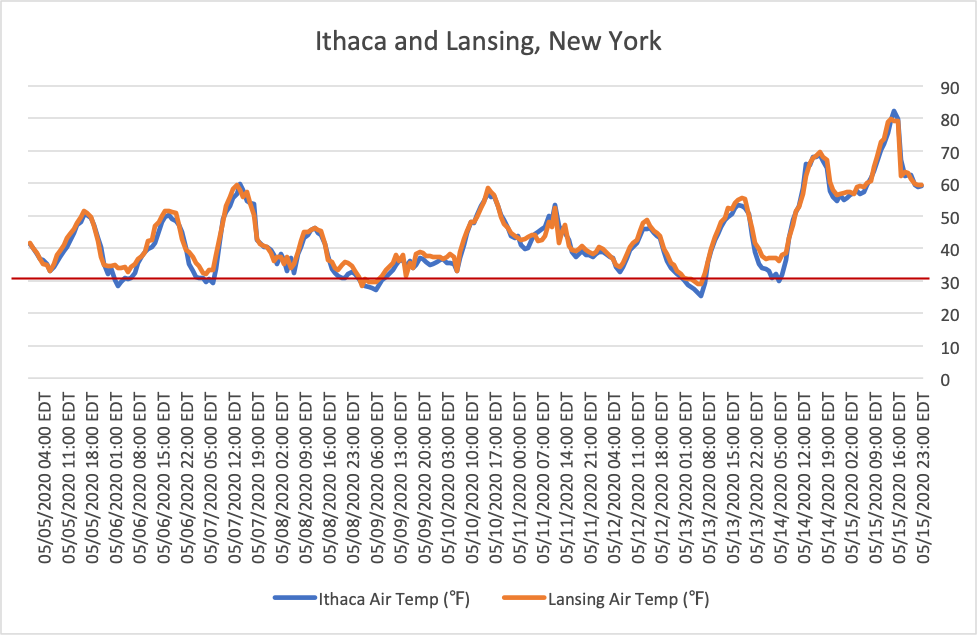
However, it’s important to note that because of the solute concentration in the flower bud cells, and the protective layers around the buds, the absolute cold temperatures typically need to be several degrees below freezing to cause damage (Figure 2). You will also notice that as the flowers develop from silver tip to petal fall, they become more susceptible to freeze damage.

The amount of damage that occurs is also very much so dependent upon the air movement, humidity, number of hours below the critical temperature, tree health, soil moisture, moisture on the bud surface, and if any frost control methods were used, such as wind machines, helicopters, overhead irrigation, or heat. A thorough discussion of frost control methods written by Michigan State University Extension Educator Amy Irish-Brown can be found at: https://www.canr.msu.edu/uploads/files/2013_NW_orchard_show/OrchardShow13Irish-Brown.pdf
Damage to the apple flowers can also vary. Typically, the king bloom (center flower in the cluster that usually becomes the largest apple at harvest) is several days more mature than the side blooms in the whorl. Thus, the king bloom is more likely to sustain damage. For culinary apple producers who sell wholesale, this can be a major problem since pricing is very much tied to fruit size. For cider producers, individual fruit size is less of an issue than tonnage per acre. Additionally, apples typically produce up to 95% more flowers than can reasonably be carried as fruit (not to mention that over-cropping leads to biennial bearing) some level of frost damage is tolerable. The threshold for how much damage is acceptable depends upon the initial flower bud load and yield expectations.
One other thing for the cider industry to remember is that many of the European cider cultivars tend to bloom later than culinary apple cultivars and crab apples. Local and regional apple industry reports tend to be more focused on culinary apples. So, how the freeze damage might affect your apple selling or purchasing this fall will depend upon the types of apples that are being used for cider.
So, how much damage occurred around the country this spring? I’ll give an update from New York and a few colleagues and growers in other regions have shared what they experienced, as well. (Note: I did some minor copy editing for clarity.)
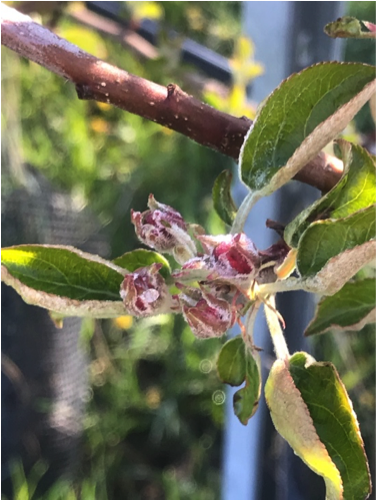
New York (May 27): In the Finger Lakes region of NY, despite temperatures down to 26 ºF in our research farm (23 ºF at my house!) we probably only sustained 10-15% damage to the earlier blooming cultivars and much less to our research cider apple trees. Several growers I’ve spoken with report similar findings. We’re now at late pink to full bloom for most of our apple cultivars with excellent pollination conditions. I suspect we’ll start out the season with the potential for a full crop. The Lake Ontario region of NY has had variable damage from none to greater than 80% of the flowers being damaged. Typically, growers who are closer to the Lake will have less frost damage because the cold water in the Lake delays flowering by several days or more. Reports from the Hudson River Valley are also variable, but more growers in that region appear to have sustained damage than those in the Finger Lakes or Lake Ontario region. Update (June 18): After surviving several frosts and a hail storm, the particularly warm temperatures during bloom have led to several cider apple growers in the Finger Lakes reporting that they have fire blight infections. For our conventionally managed research orchards, we applied streptomycin four times (we use predictive models to determine the need to use this antibiotic), but we were still not able to prevent infections. I think most of the infections were from a late afternoon shower on June 6. We had sprayed strep on June 4 after hail went through the Ithaca research orchard and with just a handful of flowers not open at that application, I thought we would be okay. Big mistake. Most of the infections started in flowers on one-year old wood, including on the central leader. We’re cutting out as much as we can, but I may need to rip out my Dabinett trees and start over. The Medaille d’Or and “Geneva” Tremlet’s Bitter trees also had a large number of fire blight strikes. There was a moderate amount of fire blight on Ellis Bitter, Harry Master’s Jersey, and Yarlington Mill. Porter’s Perfection only had a couple-few strikes, likely due to the fact that it blooms about a week earlier than the other English cider cultivars. Despite all of these issues, if we can stay ahead of the fireblight infections we should have a decent crop overall.
Renae Moran, University of Maine (May 14): “We are at the beginning of pink on Macs, and still at tight cluster for Honeycrisp. I have not checked apple buds yet, but I don’t think it got colder than 30 ºF in most places. Peaches that survived the winter are mostly still alive, but most orchards had 50% or more bud death by April. Peaches are just starting to bloom. Sweet cherries in a frost pocket are dead. The ocean effect delays bloom in Maine, and most growers have orchards at high elevation which also delays bloom. Poor soils are the compromise for escaping frost in most years.” Update (June 16): “I have not checked statewide, but in southern Maine, we had freezing temperatures around June 1, at the petal fall stage. Obvious injury to fruitlets was reported by two growers in the Newport area. In my orchard, I am seeing heavy fruit drop which is probably due to this freeze, and some due to normal thinning. I am also seeing about 10% of the apples with frost rings. Other growers are reporting the heavy fruit drop, as well.”
Terry Bradshaw, University of Vermont, Burlington, VT (May 14): “We’re actually looking pretty good here on the freeze front, although I need to check on a few folks in the southern part of the state. I’m still at early pink on most stuff, tight cluster on some. On cider varieties, a bit of half-inch-green, even. Lows haven’t been that low: 31.8 ºF on May 9th in Shoreham, 28.4 ºF in Essex where buds are tighter than ours.”
Liz Garofalo, UMass Extension Fruit Program, Belchertown, MA (May 27): “There were a few sites in MA where we dipped (on May 10, at 3am one site hit 30.7 ºF, warmed and then dropped back down to 31.7 ºF from 5-6am) below freezing for an hour or two. But, with cider varieties being largely behind others in terms of bud development, they have escaped bloom damage, and the worst that we are seeing are some crinkly leaves from prolonged cool temperatures. Of course, we are now knee deep in fireblight weather with varieties like Stoke Red just barely at pink in one location. For reference, the pink date for that particular variety and location was May 19. All of our apples look like they are setting a good crop, weather has improved, and bees are buzzing.” Update (June 16): “Nearly 75% of Massachusetts is currently experiencing “abnormally dry” weather conditions. In Belchertown at the UMass Cold Spring Research Orchard, we are down 5.38 inches from the yearly average precipitation accumulation. Tree stress caused by water deficits increases the likelihood of opportunistic pathogens and insects that would not normally pose a problem in the orchard- things like black stem borer and phomopsis. High density plantings, especially new and newly established plantings, should be receiving regular irrigation to ensure healthy trees and a healthy crop. We are not yet seeing fireblight strikes. Given the late blooming nature of some of our cider varieties, however, there is still time for strikes to show up in MA.”
Megan Muehlbauer, Rutgers University, Pittstown, NJ (May 26): “New Jersey growers have seen vast differences in frost damage to culinary apples across the state this spring, with crop losses ranging from 0 to 100%. In some instances, several feet of difference in elevation at single farms resulted in complete crop loss. At the Snyder Research Farm in Pittstown, NJ the lowest temperature recorded over the past 30 days was 31 °F. Thus, it seems the late blooming hard cider apple varieties have been spared (a few of which were still in full bloom/petal fall) as of May 25.” Update (June 18): “As of mid-June the hard cider apple crop in New Jersey is looking beautiful. It seems that they have all bloomed just late enough to avoid the most brutal of the spring frosts (Mid-April was particularly disastrous for many other crops). The fruit set looks excellent, thus far there looks to be barely any damage. I haven’t seen or heard of any particularly bad fire blight incidents either, although we have been vigilant with preventative sprays at both our research site and in discussion with growers.”

Diane Flynt, Foggy Ridge Cider, Dugspur, VA (May 13): “Spring was mostly kind here in Southwest VA—cool, with little frost damage in last weekend’s sub 28 ºF temperatures for two nights running. Wind was a big issue during bloom, with 18 to 20 mph wind most days (and nights) so spraying was a challenge. But it looks like we have decent fruit set and I hope for a good harvest. Last year I had 40 cidermakers ask to purchase our fruit, and was able to sell to only 4. All my current customers say they want to purchase again—I pass this along as a counter to anxiety growers may be facing about selling cider fruit this year. We are TINY but I do think this demand is an indication of continued interest in high quality cider apples. I hope we don’t see contraction in planting cider apples in response to the challenges cidermakers are facing in selling. Virginia Wine has done an outstanding job in communicating with the industry since isolation began in VA, and I think most of the cidermakers that were doing a decent job before the virus will come out OK.”
Tom Kon, North Carolina State University, Mills River, NC (May 26): “Southeastern apple growers (NC, SC, and GA) observed at least four frost/freeze events during spring of 2020. The polar vortex occurred when fruit was ~18 mm in diameter, but temperatures dropped slightly below freezing at most sites. While most growers avoided catastrophic losses, some blocks/sites are exhibiting sub-lethal cold injury (frost rings, russet, seed damage etc.).”
Nikki Rothwell, Michigan State University, Traverse City, MI (May 26): “We do have some damage in apples in Michigan. I think the areas in the south have more than us here in the north. It has also been pretty variety dependent. Red Delicious, which I know is not used for cider, has more damage than other varieties. However, we had great pollination weather, so I think many growers will have a decent crop. We just need to get through this fire blight weather. We are in bloom with Epiphytic Infection Potential (EIPs) in the 200-300!”
Chris Gottschalk, Michigan State University, East Lansing, MI (May 26): “On May 9th, mid-Michigan sustained temperatures of 25 ºF for two to three hours overnight. As a result, many of our early flowering cider cultivars in the Great Lakes Cider Apple Collection sustained freeze damage. Estimates ranged from 0% loss to >50% loss. For example, Chestnut crab (early blooming) was at first pink and lost >50% of its flowers to the cold. Whereas Cimitiere, a very late blooming cultivar, was at 1/2 inch green and did not suffer any damage. In general, most of our cultivars lost the king blossom but will still produce a sizable crop load this year.” Update (June 17): “The frost that Michigan experienced in early May has decreased crop load levels, for both cider and fresh market types. At the Great Lakes Cider Apple Collection, our Chestnut Crab (an early-blooming cultivar) was severely affected by the frost and has an extremely small crop load. In contrast, Vista Bella (another early-blooming cultivar) was unaffected by the frost and is supporting a high crop load. Our fresh-market industry is reporting similar results with crop load levels being very cultivar dependent. Our late-blooming cultivars, Dabinett and Cimitiere, both were unaffected by the frost and will produce a large crop this year. Many of our other accessions, that bloom at similar times to the fresh-market types, such as Sweet Alford, Yellow Newtown, Esopus Spitzenburg, Gravenstein, and Winesap all have light crop loads.”
Doug Hill, Deep Roots Orchard, Watervliet, MI (June 17): “Early bloom varieties in our orchard Redfield, Granniwinkle and Grimes Golden were negatively effected by the freeze in May. Temps dropped into the low 20’s (22-25) for several hours. Below freezing for 5-6 hours. I am happy to report that other varieties of later bloom were less affected. Browns Apple, Cox Orange Pippin, Spitzenburg, Dabinet, Harrison, Kingston Black (spotty), porters perfection. I noticed some spotty dead blooms on some of the trees but overall we feel lucky about our outcome. Trees were planted in 2017.”
Katie Nash Suding, University of Colorado, Boulder, CO (June 16): “In the Front Range of Colorado we had a late April snow storm which damaged many flowers and so we are expecting generally low fruit set.”
Brant Clark, 63rd Street Farm Orchards, Boulder County, CO (June 18): “The late cold weather, which coincided with the bulk of blossom season, more or less wiped out production for this year. We have one tree with one apple, a Golder Russet on Antonovka rootstock. Our guess is that the tree is not well (leaves more yellow than green) and so bloomed late, thereby missing the freezing event. Additionally, an earlier cold snap and major snow, measured 51cm/20″+, damaged the new leaves on early trees. Leaves which were below the snow survived with little or no damage, leaves above the snow were killed. Most of our trees are on mid and late season rootstock, so suffered little, if any, damage.”
Brady Jacobson, Mt. Hood Organic Farms, Hood River, OR (June 16): “I know the Midwest and East had severe cold weather that might have reduced the crop. We, on the other hand had great weather for bloom and set a big crop in Hood River, OR. Problem is it hailed a few nights ago, so we will have a lot more processing apples for sale this year.”
Carol Miles, Northwestern Washington Research and Extension Center, Mt. Vernon, WA (June 16): “Here in western WA we have not been negatively impacted by temperature. We have had a bit of rain though this past month, and this has led to slightly cooler temperatures, thus fruit development may be a little slow at this time in this region.”
Karen Lewis, Washington State University, Moses Lake, WA (June 17): “The apple crop looks fine in Eastern WA – we have a few pockets of frost damage but overall, if it all sticks and we manage our crop load, then we are on track. It has been a cool, wet and windy spring. Only a few warm days in May. Temperatures are on the way up this week and into next week ( 90’s). Somewhat steep increase but trees /fruit aren’t stressed.”
Jake Mann, Five Mile Orchards, Watsonville, CA (June 18): “We had two amazing seasons here in 2018 and 2019 with excellent growing conditions across the year: sufficient chilling hours and good rains, a gorgeous bloom with no frost or major precipitation during pollination, followed by a mellow summer growing season into harvest with enough folks around to pick the fruit when it was ready. 2020’s crop is looking promising, even considering this should be an alternate bearing year. Precipitation was lower this winter, but chilling hours were once again sufficient. Weather was clear and warm during bloom. Nice fruit set. Intermittent spring rains necessitated some scab control sprays, and we’ve seen outbreaks of aphis and skin worm (moths) in May and June, but have been able to keep them under control. If you wanted to say there was a pattern developing over the past three years, it’s that we’re seeing dryer winters, later accumulation of chilling, with more precipitation in spring rather than winter. The Newtown Pippin crop (our main cider apple here) looks solid, not as bountiful as last year for some blocks, but still feeling optimistic. It’s looking like a big year for our Red Delicious (not the most sought after cider fruit, true) and a worthwhile crop is growing in our other dessert fruit sections. The test blocks and grafts we have for Kingston Black, Wickson, Nehou, and some other cider-specific varieties show promise for adapting these in greater quantity to our region. The orchards didn’t get the memo about Covid… our small crew remained busy though the spring and have been able to work at a safe social distance from each other. We remain optimistic that our fruit will find it’s home in the markets this fall.”
CiderCon® Seminar: Orcharding in the West
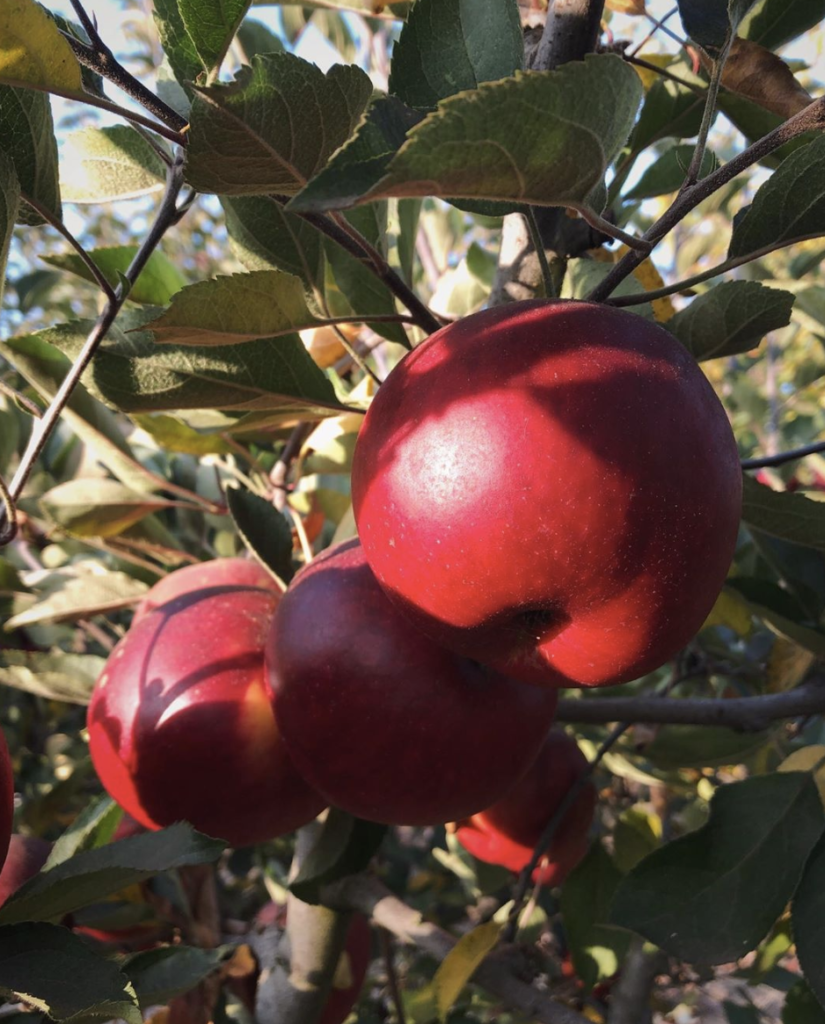
About 6 months ago, Jake Mann of Five Mile Orchard in California called me. He shared that what he loved most about CiderCon® hadn’t happened in a few years, and he wondered if it might be able to return? I didn’t need convincing. I missed it too, and this was a chance for American Cider Association to be responsive to member feedback (which we love). Jake raised his hand to help bring it back.
Jake and dedicated American Cider Association volunteer and cider expert, Darlene Hayes, have worked to bring you this year’s orcharding seminar: Orcharding in the West.
We decided to keep this seminar free for CiderCon® attendees, and there will be a scion exchange. RSVP for the workshop when you register for CiderCon®. Oh–and Jake’s orchard is featured on the Parajo Valley tour happening on January 28th!
Orcharding in the West
Wednesday, January 29th 8am – 12:30pm
FREE
Carbon Farming: Plans and Practicalities – Ryan Johnson, Consulting Team Lead for Landscape Analytic Solutions and Regen Wise
Cover Crops and the Western Orchard – Joanna Ory, Post-doctoral Fellow, U. C. Berkeley, Department of Environmental Science, Policy, and Management
Regulated Deficit Irrigation for Increasing Efficiency and Fruit Quality – Travis Alexander, Post-doctoral Research Associate, Washington State University, Mount Vernon NW Washington Research and Extension Center
Hardy Heirloom Apple Varieties from Gold-Rush Era Orchards – Amigo Bob Catisano, Founder, Felix Gillet Institute
A scion exchange will take place after the presentations. Please bring your own bag and labeling materials for collection, as well as scions from your favorite varieties.
The Gravensteins of Sonoma County
“What can I get for you?” I ask the next customer at the bar. “I don’t know. Do you have any cider made with Gravenstein apples?”, comes the reply. “All the ciders on our menu have some Gravenstein in them. What sort of cider do you like?”
That’s a typical beginning conversation at the Craft Cider Tent of the Gravenstein Apple Fair, an annual fundraising event benefiting the local agricultural non-profit Sonoma County Farm Trails. Most of our customers are not regular cider drinkers, and have generally just tried one or another of the large nationally distributed brands. Confronted with a menu of 18 local ciders, from almost as many producers, they are understandably a bit flummoxed. We talk about what they typically drink, do a little sampling, and eventually find something they love.
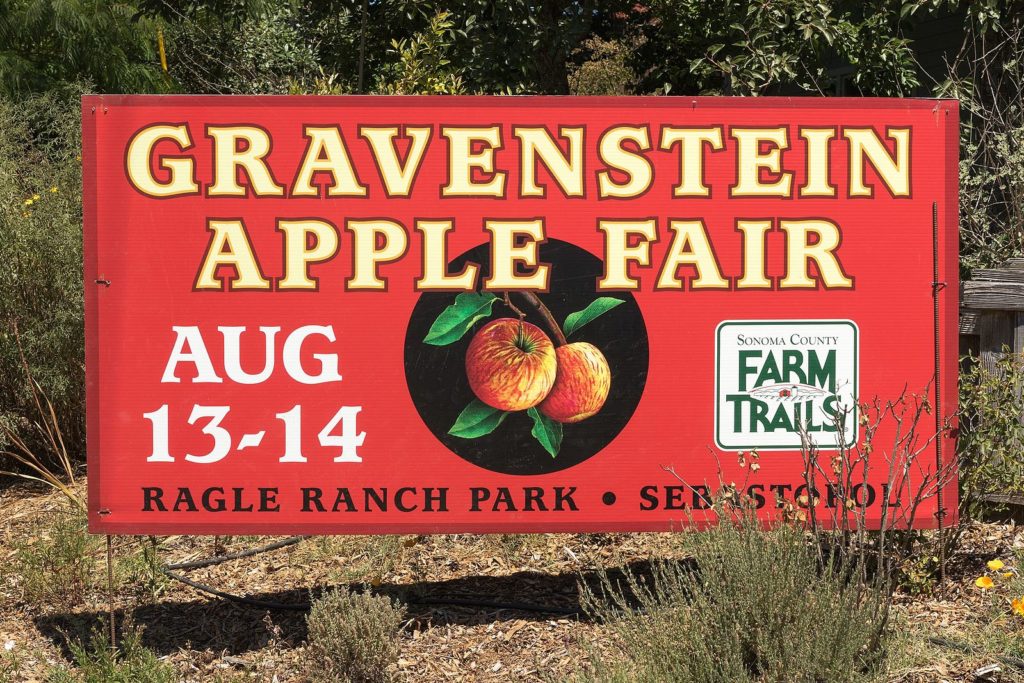
When most people hear “Sonoma County, CA” they think wine, but apples have been a part of the commercial landscape there since northern Europeans arrived in the mid-19th century. Chief among them was, and is, the Gravenstein, an apple whose 18th century origins (said to be Italy, Denmark, or Germany) are shrouded in mystery. It’s an apple that expresses itself marvelously in the area’s loamy soils, warm, dry days, and cool summer nights. Nineteenth century pomologists had it right when they described the Gravenstein as having “that refreshing admixture of sweet and acid which characterize our most esteemed apples” and declaring it good for cider.
Cider makers in the area take full advantage of everything the Gravenstein has to offer making ciders that cover all possible flavor and texture bases – wild and tart native-ferments (Old World Winery and Coturri Winery); dry and fruit forward (Sawhorse Cider and Horse & Plow Winery); clean and crisp (Goat Rock and Ethic Ciders); semi-dry single varietals (California Cider Company and Golden State Cider), and complex blends (tannic from Tilted Shed Ciderworks, aromatic from Dutton Estates). The 10-fold increase in local cider companies over the last seven years has been a boon to local farmers, too, allowing them to resist the economic pressure to grub up their orchards in favor of wine grapes.
While the range of flavor possibilities seems almost endless, what these ciders all have in common is their use of local fruit, typically dry-farmed and organic, harvested and pressed in season. They also rarely make it outside of Northern California, and most can only be found within Sonoma County itself and the handful of counties that surround it. To experience all this place has to offer, you have to go there.
The American Cider Association is making it easy for the attendees of CiderCon 2020 in nearby Oakland to do just that with a pre-conference orchard and tasting tour. For cider lovers, it’s an opportunity that shouldn’t be missed.
American Cider Association Note: Registration for CiderCon 2020 and associated tours will open soon! Darlene Hayes will be the guide for the Sonoma Country tour.

